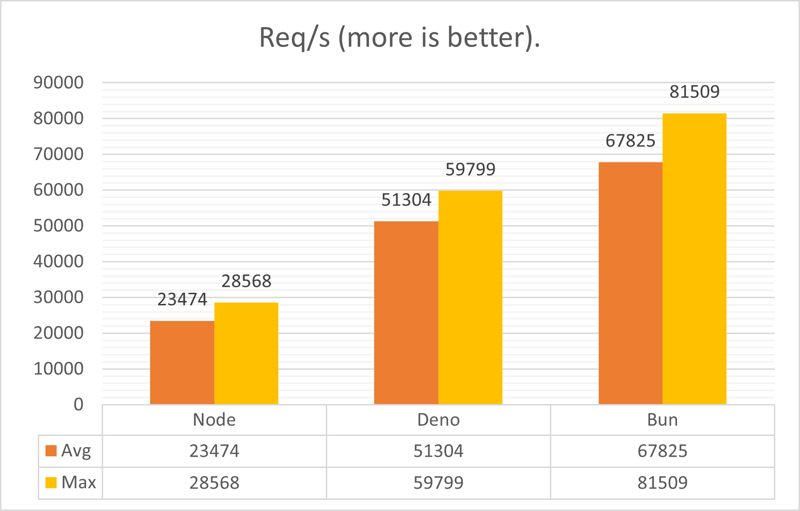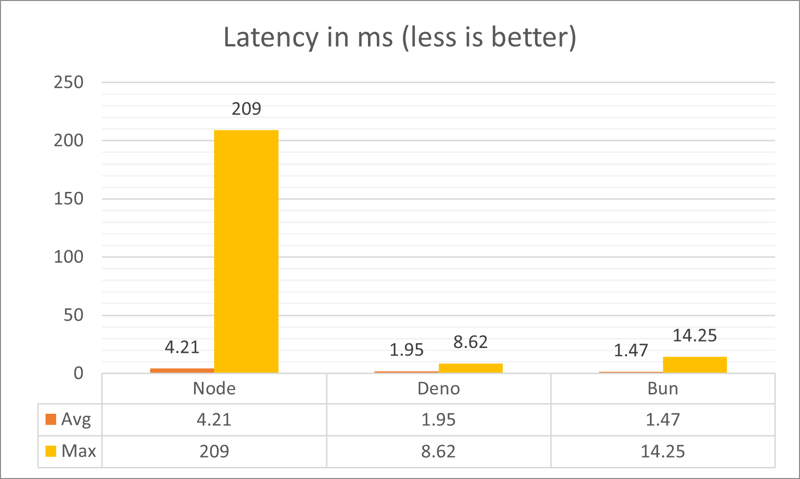Hono.js Benchmark: Node.js vs. Deno vs. Bun — Which Is the Fastest?
Deno 2.0 just came out and claimed to be faster than Bun and Node.js and the same way Bun claims to be quicker. This caught my interest, so I decided to put their performance to the test and see how they compare in a real-world scenario.
For a fair comparison, I need to choose a framework compatible with all three JavaScript runtime environments (Node.js, Deno, and Bun). That’s why I decided to use Hono.js, which integrates seamlessly with all three.
Test Environment:
OS: Ubuntu 24.04.1 LTS (WSL)
System: Ryzen 5 5500U, 16GB RAM
Node.js: v22.9.0
Deno: v2.0.0
Bun: v1.1.30
Test Command:
bombardier -c 100 -d 30s http://localhost:3000
For benchmarking, I used Bombardier, a Go-based load testing tool that runs for 30 seconds with 100 concurrent connections. Each test was repeated three times to ensure more accurate results, and the average of these runs was taken for each environment.
The Framework: Hono.js
I selected Hono.js for its flexibility and cross-compatibility. Hono.js allows easy integration with all three JavaScript runtimes — Node.js, Deno, and Bun — making it an ideal framework for this kind of benchmark. It’s lightweight, fast, and has a simple API, which ensures that the performance differences between the runtimes are highlighted without much overhead.
Result
Here are the average and maximum requests per second for each runtime:
 (Request/sec)
(Request/sec)
Winner: Bun
Here are the latency (in milliseconds per request) for each runtime is shown below:
 (ms/req)
(ms/req)
Winner: Bun (Avg) & Deno (Max)
Analysis and Key Takeaways
Based on the results, the following key points emerged:
Node.js: While Node.js has been the industry standard for server-side JavaScript for years, it shows lower performance in terms of requests per second when compared to both Deno and Bun. Its average latency is also higher, suggesting that it may struggle more under heavy concurrent loads. However, Node.js is still widely adopted for its vast ecosystem and stability in production environments.
Deno 2.0: Deno performed significantly better than Node.js, delivering more than double the requests per second while maintaining a much lower average latency. This indicates that Deno is highly optimized for handling concurrent connections and could be a strong alternative for performance-critical applications. Its modern design and built-in features like TypeScript support give it an edge in newer projects.
Bun: Bun outperformed both Node.js and Deno in terms of raw performance. It handled the highest number of requests per second and maintained the lowest average latency. This makes Bun a compelling option for projects where speed is the top priority. However, it is still a newer runtime, and its ecosystem and community are not yet as mature as those of Node.js.
Conclusion
In this benchmark, I tested the performance of Deno 2.0, Bun, and Node.js using Hono.js as the framework across all three environments. The results clearly show that both Deno and Bun outperform Node.js in terms of raw speed and latency. Bun, in particular, shines in high-performance scenarios, while Deno provides a balanced solution with a focus on modern development features.
While Node.js may not be the fastest option, it remains a reliable choice, especially for projects that rely on its mature ecosystem. On the other hand, if you’re working on a new project and need to maximize performance, both Deno and Bun offer compelling alternatives.
Ultimately, the choice of runtime will depend on your project’s specific needs. For now, Deno and Bun have proven themselves as the new contenders in the JavaScript runtime race, with Bun taking a noticeable lead in performance.
-
 How do I combine two associative arrays in PHP while preserving unique IDs and handling duplicate names?Combining Associative Arrays in PHPIn PHP, combining two associative arrays into a single array is a common task. Consider the following request:Descr...Programming Published on 2024-11-13
How do I combine two associative arrays in PHP while preserving unique IDs and handling duplicate names?Combining Associative Arrays in PHPIn PHP, combining two associative arrays into a single array is a common task. Consider the following request:Descr...Programming Published on 2024-11-13 -
 Using WebSockets in Go for Real-Time CommunicationBuilding apps that require real-time updates—like chat applications, live notifications, or collaborative tools—requires a communication method faster...Programming Published on 2024-11-13
Using WebSockets in Go for Real-Time CommunicationBuilding apps that require real-time updates—like chat applications, live notifications, or collaborative tools—requires a communication method faster...Programming Published on 2024-11-13 -
 Beyond `if` Statements: Where Else Can a Type with an Explicit `bool` Conversion Be Used Without Casting?Contextual Conversion to bool Allowed Without a CastYour class defines an explicit conversion to bool, enabling you to use its instance 't' di...Programming Published on 2024-11-13
Beyond `if` Statements: Where Else Can a Type with an Explicit `bool` Conversion Be Used Without Casting?Contextual Conversion to bool Allowed Without a CastYour class defines an explicit conversion to bool, enabling you to use its instance 't' di...Programming Published on 2024-11-13 -
 How Can I Find Users with Today\'s Birthdays Using MySQL?How to Identify Users with Today's Birthdays Using MySQLDetermining if today is a user's birthday using MySQL involves finding all rows where ...Programming Published on 2024-11-13
How Can I Find Users with Today\'s Birthdays Using MySQL?How to Identify Users with Today's Birthdays Using MySQLDetermining if today is a user's birthday using MySQL involves finding all rows where ...Programming Published on 2024-11-13 -
 What Happened to Column Offsetting in Bootstrap 4 Beta?Bootstrap 4 Beta: The Removal and Restoration of Column OffsettingBootstrap 4, in its Beta 1 release, introduced significant changes to the way column...Programming Published on 2024-11-13
What Happened to Column Offsetting in Bootstrap 4 Beta?Bootstrap 4 Beta: The Removal and Restoration of Column OffsettingBootstrap 4, in its Beta 1 release, introduced significant changes to the way column...Programming Published on 2024-11-13 -
 How to Fix \"ImproperlyConfigured: Error loading MySQLdb module\" in Django on macOS?MySQL Improperly Configured: The Problem with Relative PathsWhen running python manage.py runserver in Django, you may encounter the following error:I...Programming Published on 2024-11-13
How to Fix \"ImproperlyConfigured: Error loading MySQLdb module\" in Django on macOS?MySQL Improperly Configured: The Problem with Relative PathsWhen running python manage.py runserver in Django, you may encounter the following error:I...Programming Published on 2024-11-13 -
 Image slider carosual using html css and javascript https://www.instagram.com/webstreet_code/? Image Carousel with Thumbnails & Hover Effects ? Hey, dev community! ? In my latest video, I built an elegant image carousel featuring thumbnails th...Programming Published on 2024-11-12
Image slider carosual using html css and javascript https://www.instagram.com/webstreet_code/? Image Carousel with Thumbnails & Hover Effects ? Hey, dev community! ? In my latest video, I built an elegant image carousel featuring thumbnails th...Programming Published on 2024-11-12 -
 The Heart of React: Understanding Component RerenderingWhen learning a programming language, we often dive into syntax and focus on building something quickly, sometimes overlooking a crucial question: Wha...Programming Published on 2024-11-12
The Heart of React: Understanding Component RerenderingWhen learning a programming language, we often dive into syntax and focus on building something quickly, sometimes overlooking a crucial question: Wha...Programming Published on 2024-11-12 -
 What\'s the Distinction Between Deferreds, Promises, and Futures in JavaScript?Differences Between Deferreds, Promises, and Futures in JavaScriptIn JavaScript, deferreds, promises, and futures are commonly used to handle asynchro...Programming Published on 2024-11-12
What\'s the Distinction Between Deferreds, Promises, and Futures in JavaScript?Differences Between Deferreds, Promises, and Futures in JavaScriptIn JavaScript, deferreds, promises, and futures are commonly used to handle asynchro...Programming Published on 2024-11-12 -
 Why are Gorilla Sessions Variables Not Maintained Across Requests in My Web Application?Session Variables in Gorilla Sessions Not Maintained While Using ThemIssueWhile using Gorilla Sessions web toolkit, session variables are not retained...Programming Published on 2024-11-12
Why are Gorilla Sessions Variables Not Maintained Across Requests in My Web Application?Session Variables in Gorilla Sessions Not Maintained While Using ThemIssueWhile using Gorilla Sessions web toolkit, session variables are not retained...Programming Published on 2024-11-12 -
 How to Display Columnized Data in Python Like the \'column -t\' Command?Displaying Columnized Data in PythonIn the realm of command-line administration tools, it is often desirable to present data in well-aligned columns. ...Programming Published on 2024-11-12
How to Display Columnized Data in Python Like the \'column -t\' Command?Displaying Columnized Data in PythonIn the realm of command-line administration tools, it is often desirable to present data in well-aligned columns. ...Programming Published on 2024-11-12 -
 Efficient Ways to Find a Specific Row in a NumPy Array: Questions and SolutionsFinding Instances of a Specific Row in a NumPy Array EfficientlyWhen working with NumPy arrays, one may encounter the need to determine if the array c...Programming Published on 2024-11-12
Efficient Ways to Find a Specific Row in a NumPy Array: Questions and SolutionsFinding Instances of a Specific Row in a NumPy Array EfficientlyWhen working with NumPy arrays, one may encounter the need to determine if the array c...Programming Published on 2024-11-12 -
 How to Solve the \"_tkinter.TclError: no display name and no $DISPLAY environment variable\" Issue for Python Scripts Using Matplotlib on a Server?_tkinter.TclError: no display name and no $DISPLAY environment variableIssuePython scripts using Matplotlib fail on a server with the error "no d...Programming Published on 2024-11-12
How to Solve the \"_tkinter.TclError: no display name and no $DISPLAY environment variable\" Issue for Python Scripts Using Matplotlib on a Server?_tkinter.TclError: no display name and no $DISPLAY environment variableIssuePython scripts using Matplotlib fail on a server with the error "no d...Programming Published on 2024-11-12 -
 How do I Recursively Delete Directories in Java Using Apache Commons IO?Recursing Through Directories for Deletion in JavaDeleting an empty directory in Java is straightforward. However, the process becomes more complex wh...Programming Published on 2024-11-12
How do I Recursively Delete Directories in Java Using Apache Commons IO?Recursing Through Directories for Deletion in JavaDeleting an empty directory in Java is straightforward. However, the process becomes more complex wh...Programming Published on 2024-11-12 -
 Why Does My JavaFX Application Throw \"Location is Required.\" Error Even With FXML in the Same Package?JavaFX "Location is required." Error Despite FXML in Same PackageIn JavaFX applications, encountering the "java.lang.NullPointerExcepti...Programming Published on 2024-11-12
Why Does My JavaFX Application Throw \"Location is Required.\" Error Even With FXML in the Same Package?JavaFX "Location is required." Error Despite FXML in Same PackageIn JavaFX applications, encountering the "java.lang.NullPointerExcepti...Programming Published on 2024-11-12
Study Chinese
- 1 How do you say "walk" in Chinese? 走路 Chinese pronunciation, 走路 Chinese learning
- 2 How do you say "take a plane" in Chinese? 坐飞机 Chinese pronunciation, 坐飞机 Chinese learning
- 3 How do you say "take a train" in Chinese? 坐火车 Chinese pronunciation, 坐火车 Chinese learning
- 4 How do you say "take a bus" in Chinese? 坐车 Chinese pronunciation, 坐车 Chinese learning
- 5 How to say drive in Chinese? 开车 Chinese pronunciation, 开车 Chinese learning
- 6 How do you say swimming in Chinese? 游泳 Chinese pronunciation, 游泳 Chinese learning
- 7 How do you say ride a bicycle in Chinese? 骑自行车 Chinese pronunciation, 骑自行车 Chinese learning
- 8 How do you say hello in Chinese? 你好Chinese pronunciation, 你好Chinese learning
- 9 How do you say thank you in Chinese? 谢谢Chinese pronunciation, 谢谢Chinese learning
- 10 How to say goodbye in Chinese? 再见Chinese pronunciation, 再见Chinese learning

























